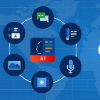Generative Artificial Intelligence (AI) models can propose solutions to scientific problems beyond human capability. To truly make conceptual contributions, researchers need to be capable of understanding the AI-generated structures and extracting the underlying concepts and ideas. When algorithms provide little explanatory reasoning alongside the output, scientists have to reverse-engineer the fundamental insights behind proposals based solely on examples. This task can be challenging as the output is often highly complex and thus not immediately accessible to humans. In this work we show how transferring part of the analysis process into an immersive Virtual Reality (VR) environment can assist researchers in developing an understanding of AI-generated solutions. We demonstrate the usefulness of VR in finding interpretable configurations of abstract graphs, representing Quantum Optics experiments. Thereby, we can manually discover new generalizations of AI-discoveries as well as new understanding in experimental quantum optics. Furthermore, it allows us to customize the search space in an informed way - as a human-in-the-loop - to achieve significantly faster subsequent discovery iterations. As concrete examples, with this technology, we discover a new resource-efficient 3-dimensional entanglement swapping scheme, as well as a 3-dimensional 4-particle Greenberger-Horne-Zeilinger-state analyzer. Our results show the potential of VR for increasing a human researcher's ability to derive knowledge from graph-based generative AI that, which is a common abstract data representation used in diverse fields of science.
翻译:暂无翻译




